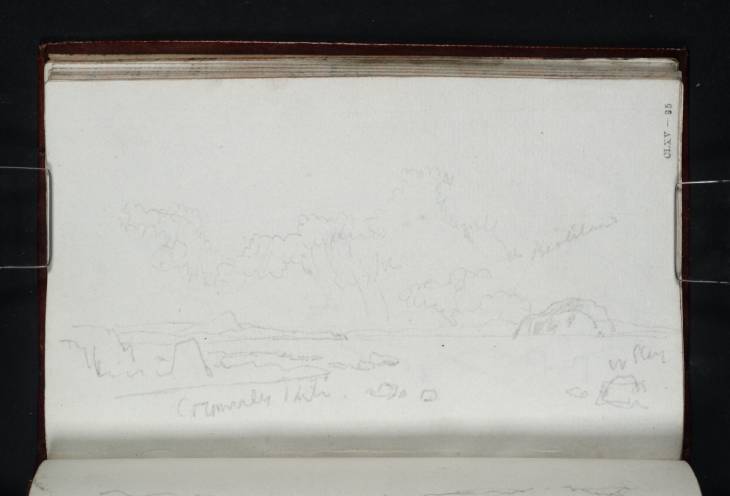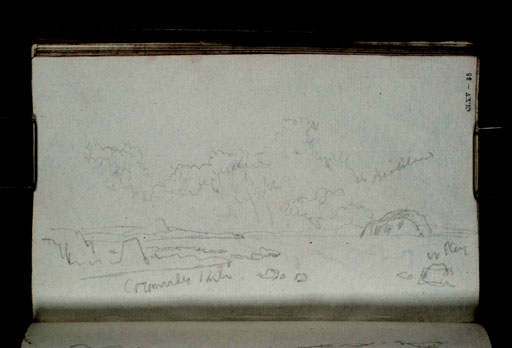Joseph Mallord William Turner Bass Rock and Rocks on the East Lothian Coast 1818
Image 1 of 2
Joseph Mallord William Turner,
Bass Rock and Rocks on the East Lothian Coast
1818
Joseph Mallord William Turner 1775–1851
Folio 35 Recto:
Bass Rock and Rocks on the East Lothian Coast 1818
D13383
Turner Bequest CLXV 35
Turner Bequest CLXV 35
Pencil on white laid paper, 99 x 159 mm
Inscribed in pencil by Turner ?‘Cromwell’s stile’ bottom centre, ?‘Baldred [...]’ middle right, ?‘W Stack’ bottom right, ‘light’ centre
Stamped in black ‘CLXC 35’ top right running vertically
Inscribed in pencil by Turner ?‘Cromwell’s stile’ bottom centre, ?‘Baldred [...]’ middle right, ?‘W Stack’ bottom right, ‘light’ centre
Stamped in black ‘CLXC 35’ top right running vertically
Accepted by the nation as part of the Turner Bequest 1856
References
1909
A.J. Finberg, A Complete Inventory of the Drawings of the Turner Bequest, London 1909, vol.I, p.479, CLXV 35, as ‘Rocks on Coast – “Cromwell’s Stile” (?), &c.’.
Turner’s inscriptions on this page remain obscure. According to modern maps there is nothing on the East Lothian Coast that fits Finberg’s reading of ‘Cromwell’s stile’ (bottom left of the page), or ‘w stack’, which presumably means west stack, an inscription also made on folio 16 verso (D13352; CLXV 16a) which shows the crags off Dunbar. However there are various crags off the coast of Dunbar and up the coast towards Tantallon with names including ‘steeple’ and ‘spikes’; local names may have varied from those in printed maps, and it is not uncommon for Turner to misspell names or get them mixed up. More useful than Turner’s inscriptions is the island on the right, which is probably the Bass Rock, also depicted on the opposite page (folio 34 verso; D13382; CLXV 34a) and numerous times in this sketchbook. Considering the angle at which the island is seen and the rocks in the foreground it is therefore likely that this drawings was made at some point along the coast between Great Car (opposite Tantallon Castle) and Long Craigs (just north of Dunbar). An indecipherable inscription, missed by Finberg, may read ‘Baldred’s Boat’ or ‘Baldred’s Cradle’, both rocky outcrops along this point of the coast.
This drawing, although not highly finished, is certainly more carefully composed than many of the quick sketches in this book, and is one of the few drawings in which Turner depicted the weather (see Tour of Scotland 1818 Tour Introduction; also folio 11 verso; D13342; CLXV 11a for another drawing of clouds and the Bass Rock). The rocky outcrops in the foreground frame the drawing and also point to the main subject – Bass Rock – to the right. The rock labelled ‘W stack’ in the bottom right corner helps to balance the composition, and the top half of the picture is filled by a wide expanse of sky with some fascinating low cloud formations. Turner has written ‘light’ across an area of cloud, and a few lines of hatching are enough to indicate a darker area. In Turner’s watercolour of Bass Rock, circa 1824 (Lady Lever Art Gallery, Port Sunlight),1 clouds are again a major feature of the composition, allowing Turner to make the sky as pictorially fascinating as the sea and rock, and to explore the relationship of white and blue across the entire picture. The calm of this sketch, however, is replaced in the watercolour by a raging storm, complete with lightning bolt.
Verso:
Blank
Thomas Ardill
October 2007
How to cite
Thomas Ardill, ‘Bass Rock and Rocks on the East Lothian Coast 1818 by Joseph Mallord William Turner’, catalogue entry, October 2007, in David Blayney Brown (ed.), J.M.W. Turner: Sketchbooks, Drawings and Watercolours, Tate Research Publication, December 2012, https://www


